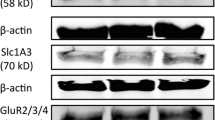Abstract
During murine embryogenesis, uptake sites for the neurotransmitter serotonin (5-HT) are transiently expressed in craniofacial epithelial structures. Based on malformations produced in cultured mouse embryos exposed to uptake inhibitors or receptor ligands, we have proposed that 5-HT acts as a dose-dependent morphogenetic signal during critical periods of craniofacial development. Several 5-HT receptor subtypes are co-distributed with tenascin and the calcium binding protein S-100β in developing craniofacial mesenchyme. Since these molecules are thought to be important for craniofacial development, their regulation by 5-HT could mediate some of its morphogenetic actions. Mandibular mesenchyme cells, from E12 mouse embryos (plug day=E1), grown in micromass cultures were used as an in vitro model to investigate whether 5-HT regulates expression of these molecules. Immunocytochemistry revealed expression of S-100β, tenascin, cartilage proteoglycan core protein (a component of the cartilage matrix) and a variety of 5-HT receptors in these cultures. To block the actions of 5-HT (from serum in the culture medium), cultures were exposed to one of these selective 5-HT receptor antagonists and effects on expression were investigated using quantitative immunobinding and in situ hybridization assays. These antagonists differentially regulated expression of cartilage core protein, S-100β and tenascin. Antagonism of 5-HT3 receptors by Zofran or 5-HT1A receptors by NAN-190 reduced the amount of core protein, whereas antagonism of 5-HT2A-C receptors by mianserin had no significant effect. All three antagonists stimulated levels of tenascin mRNA and protein. Expression of S-100β mRNA and protein was inhibited by Zofran and stimulated by mianserin, whereas NAN-190 had no significant effect. The differential effects of antagonists suggest that in vivo, 5-HT could: (1) promote expression of cartilage core protein by activation of 5-HT3 or 5-HT1A receptors, (2) inhibit production of tenascin by activation of multiple receptors, (3) promote or inhibit synthesis of S-100β by activation of 5-HT3 or 5-HT2 receptors, respectively. These actions may be important components of the morphogenetic functions of 5-HT during craniofacial development.
Similar content being viewed by others
Author information
Authors and Affiliations
Additional information
Accepted: 12 June 1996
Rights and permissions
About this article
Cite this article
Moiseiwitsch, J., Lauder, J. Regulation of gene expression in cultured embryonic mouse mandibular mesenchyme by serotonin antagonists. Anat Embryol 195, 71–78 (1996). https://doi.org/10.1007/s004290050026
Issue Date:
DOI: https://doi.org/10.1007/s004290050026



